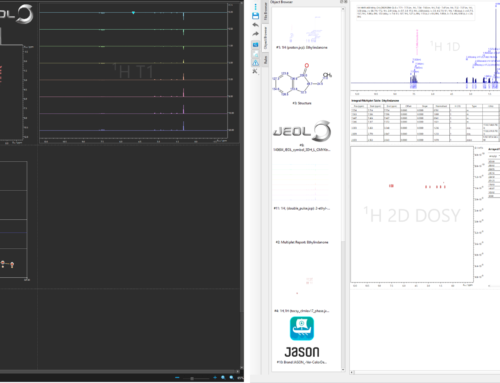JASON 5.1 is packed with new features, whether you are using JASON for qNMR, solid-state NMR, automation or your everyday NMR processing, analysis and reporting – we have something new or updated for every user!
Check out the full list of new features here.
Let’s start by looking at the plugins:
SolidSpin

JASON 5.1 brings with it the new solid-state simulation plugin: SolidSpin.
You can now simulate solid-state NMR spectra within JASON using the power of SIMPSON, the popular simulation program. Using these simulations, you can fit your experimental spectra using these simulations. If customization is your need, we have you covered as you can easily introduce new user specified simulations using custom scripts.
The SolidSpin plugin is free to all users with a valid JASON license and can be installed from the plugin manager.
Give it a spin today and let us know how you get along!
A new version of SMILEQ
Following the theme of updates to plugins, we bring you a new version of SMILEQ as part of JASON 5.1.
qNMR users can now use the concentration conversion factors directly in SMILEQ calculations.
There are updates for statistical analysis including ANOVA statistical analysis as part of the workflow and the SMILEQ summary report now shows the overall average and statistics over multiple samples.
In addition, SMILEQ can now report signal-to-noise (SNR) for integral ranges in the results table.

Molecules
The 3D molecular viewer got its own upgrade, allowing users to place static images from the 3D molecule viewer onto the canvas with a click of a button. Rotate your molecule to your hearts content to find its most photogenic side before adding its portrait onto the canvas!
Watch my ibuprofen molecule get its photoshoot here:
NMR Processing
There have been many enhancements to the NMR processing engine for you in this new version. 1D spectra can now take advantage of a new processing function to allow the normalization of vertical intensity, the shrink processing provides more sensible parameters adjusted to actual data to make using it simpler, and processing large 2D NUS files is much faster on the Mac now.
The preview of Apodization processing has been enhanced so that you now see the live preview of your changes to the parameters on your spectrum, similarly to the interactive baseline correction mode. We hope that you find this improves your user experience and speeds up your work.
Talking of improving your user experience, we also show a preview of your experiment type at the top of the processing widget, helping you quickly and effectively choose the right processing for your NMR experiment.
Download and try it now!
This version of JASON is so jammed packed with new features, updates and enhancements that I don’t have space to cover all of them here! The best way to see them all in action is to download or update your JASON here and see them for yourself!


